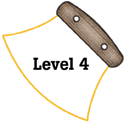
Alaska Science
Key Element A7
 |
Alaska Science |
|
Performance Standard Level 4, Ages 15–18
|
|
|
|
Sample Assessment Ideas
|
Standards Cross-References
|
||
|
National Science Education Standards Earth systems have internal and external sources of energy, both of which create heat. The sun is the major external source of energy. Two primary sources of internal energy are the decay of radioactive isotopes and the gravitational energy from the Earth’s original formation. (Page 189) The outward transfer of Earth’s internal heat drives convection circulation in the mantle which propels the plates comprising Earth’s surface across the face of the globe. (Page 189) Heating of Earth’s surface and atmosphere by the sun drives convection within the atmosphere and oceans, producing winds and ocean currents. (Page 189) The Earth is a system containing essentially a fixed amount of each stable chemical atom or element. Each element can exist in several different chemical reservoirs. Each element on Earth moves among reservoirs in the solid Earth, oceans, atmosphere, and organisms as part of geochemical cycles. (Page 189) Movement of matter between reservoirs is driven by the Earth’s internal and external sources of energy. These movements are often accompanied by a change in the physical and chemical properties of the matter. Carbon, for example, occurs in carbonate rocks such as limestone, in the atmosphere as carbon dioxide gas, in water as dissolved carbon dioxide, and in all organisms as complex molecules that control the chemistry of life. (Page 189) Geologic time can be estimated by observing rock sequences and using fossils to correlate the sequences at various locations. Current methods includes using the known decay rates of radioactive isotopes present in rocks to measure the time since the rock was formed. (Page 189) Interactions among the solid Earth, the oceans, the atmosphere, and organisms have resulted in the ongoing evolution of the Earth system. We can observe some changes such as earthquakes and volcanic eruptions on a human time scale, but many processes such as mountain building and plate movements take place over hundreds of millions of years. (Page 189) |
Benchmarks The formation, weathering, sedimentation, and reformation of rock constitute a continuing “rock cycle” in which the total amount of material stays the same as its forms change. (Page 74) The slow movement of material within the Earth results from heat flowing out from the deep interior and the action of gravitational forces on regions of different density. (Page 74) The solid crust of the Earth—including both the continents and the ocean basins—consist of separate plate that ride on a denser, hot, gradually deformable layer of the Earth. The crust sections move very slowly, pressing against one another in some places, pulling apart in other places. Ocean floor plates may slide under continental plates, sinking deep into the Earth. The surface layers of these plates may fold, forming mountain ranges. (Page 74) Earthquakes often occur along the boundaries between colliding plates, and molten rock from below creates pressure that is released by volcanic eruptions, helping to build up mountains. Under the ocean basins, molten rock may well up between separating plates to create new ocean floor. Volcanic activity along the ocean floor may form undersea mountains, which can thrust above the ocean’s surface to become islands. (Page 74) |
|
Table of Contents | Return to Alaska Native Knowledge Network